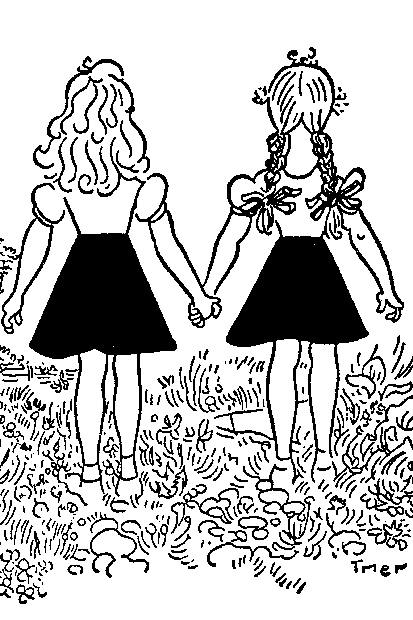If it’s all right with you, I’d like to launch a campaign please. Right here. You may be wanting me to cut to the chase and just recommend some children’s books, but bear with me. I’m on the case.
My campaign is to have pictures in books again. Adult books too, but obviously books for children. There are some wonderful illustrators out there, contemporary ones, for all ages, and the scandalous thing is, they are usually limited to the age range, 0–7. If you want to remind yourself what we’re missing, make for the House of Illustration in London’s King’s Cross; that should do it. Or try Chris Beetles’s annual, brilliant exhibition, The Illustrators, on now at his St James’s gallery.
There are so many books where it’s the combination of author and illustrator that makes you love them. In the case of The Flying Classroom and The Parent Trap (£7.99 each, Spectator Bookshop, £7.59 each) by Erich Kästner, now republished by the ever brilliant Pushkin, it’s the combo of author, illustrator and translator. The bold line drawings by Walter Trier are the work of genius — he was quite something, was Trier. As for the stories, if you’re a fan of Emil and the Detectives, then you’ll find these just as spirited, with the same element of children pitted against the world. The translation, by Anthea Bell, who did Asterix, is very fine.
Younger children have it made when it comes to pictures, but I wouldn’t let them keep picture books for themselves. Some are just too good. Take This is Not My Hat by Jon Klassen (Walker, £6.99, Spectator Bookshop, £6.64), an account of a little fish nicking a hat from a big fish, more or less the theme of his equally fabulous I Want My Hat Back. Something simple for infants? Actually, it’s one of the funniest books of the year.

Lauren Child’s childlike drawings and all-over-the-place lettering are the art that conceals art. Her latest, The New Small Person (Puffin, £6.99, Spectator Bookshop, £6.64) is a child’s-eye view of a new arrival in the family, and it’s charming.
Jan Pienkowski does things with scissors, Polish style, to make silhouettes of a delicacy and vivacity you wouldn’t believe, and in The Glass Mountain (Walker, £12.99, Spectator Bookshop, £10.99) he’s on cracking form. It’s a collection of Polish folk tales retold by David Walser. The pictures are flamboyantly colourful and the imagination bounces off them to realms of wonder and menace. By the way, if you’re looking for a captivating book of Bible stories, simply told, can I recommend Mr P’s In the Beginning (Walker, £12.99, Spectator Bookshop, £10.99)?
One of the finest illustrators of the 20th century was Edward Ardizzone, and Jonathan Cape have had the brilliant idea of republishing the children’s books where he collaborated with Graham Greene. Funnily enough, it’s Greene who lets them down a bit. Not everyone can write for children, and GG was a bit too knowing in these stories about the bravery and resourcefulness of four looked-down-upon vehicles (The Little Steamroller,The Little Train, The Little Fire Engine and The Little Horse Bus (£14.99 each, Spectator Bookshop, £12.99) — but the period detail is beyond affecting and the pictures are, well, wonderful. Beats Thomas the Tank Engine.
Axel Scheffler is an illustrator that every child knows from The Gruffalo; in Christmas Poems, chosen by Gaby Morgan (Macmillan, £5.99), he animates a lovely collection of poetry — from William Blake to Ogden Nash — with little drawings of kings, stars and mince pies. But not enough big pictures. More!
Chris Riddell is not just one of the most distinctive contemporary illustrators but one of the most prolific — he’s a political cartoonist too — and among his offerings this year are two crackers. One is Goth Girl and the Fete Worse than Death (Macmillan, £10.99, Spectator Bookshop, £9.89), which he wrote and illustrated. It’s his riff on Mervyn Peake’s Gormenghast crossed with Downton Abbey and the Great British Bake Off (his drawings of Heston Harboil, experimental baker, and Mary Huckleberry are a joy). If that sounds zany and fun, it is. There are puns for the cognoscenti here on every page. In The Sleeper and the Spindle (£12.99, Spectator Bookshop, £10.99), Neil Gaiman’s new take on Sleeping Beauty, the pictures — black, grey and gold — are unsettling and beautiful.
Emily Gravett’s illustrations for A.F. Harrold’s The Imaginary (Bloomsbury, £12.99, Spectator Bookshop, £10.99) take this unsettling account of what happens to an imaginary friend when the child imagining him stops doing so into the realm of downright creepiness. Far from being heartwarming, it’s an uncomfortable, if compelling, read, and the pictures add to the menace, especially the one where the man who eats imaginaries starts on our hero.
Tony Ross’s drawings for David Walliams’s Awful Auntie (Harper Collins, £12.99, Spectator Bookshop, £10.99) are subversive, scratchy and anarchic — the perfect take, then, on a subversive anarchic tale, one of Walliams’s best. This is the nearest we get in this fallen world to the combo of Roald Dahl and Quentin Blake.
It’s really, really difficult to write animal stories which do justice to the nature of the animals and the human need for a human story, but the naturalist Tom Moorhouse as managed, in The Rising (Oxford, £10.99, Spectator Bookshop, £9.89), to produce yet another compelling story about… water voles. And if there’s one thing harder than making the adventures of these creatures a riveting read, unless you’re taking the Kenneth Grahame route, it’s drawing pictures of them. Yet that has been managed too — by Simon Mendez. Thank God there was a rat in the story. Watership Down, 2014, with water voles.







Comments